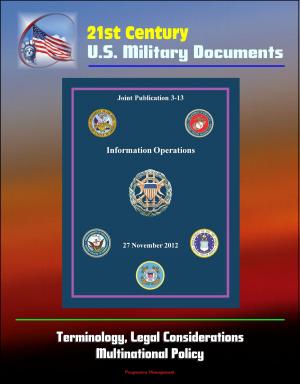How America Saved Italy and the World: Using Bretton Woods and the Marshall Plan after World War II to Bring Stability and Peace to Europe through Instruments of National Power, Blocking Communism
Nonfiction, History, Italy, Military, World War II| Author: | Progressive Management | ISBN: | 9781370094974 |
| Publisher: | Progressive Management | Publication: | March 2, 2017 |
| Imprint: | Smashwords Edition | Language: | English |
| Author: | Progressive Management |
| ISBN: | 9781370094974 |
| Publisher: | Progressive Management |
| Publication: | March 2, 2017 |
| Imprint: | Smashwords Edition |
| Language: | English |
This excellent report has been professionally converted for accurate flowing-text e-book format reproduction. As early as World War I, the United States possessed a vision for how to eliminate the propensity of interstate warfare. Actually achieving this vision proved difficult until after World War II. Then, US policy makers used a mix of security, economic, and regional incentives to bring their global vision into fruition. The 1948 Marshall Plan balanced the priorities of Italy's local security, economic, and regional security concerns to be effective. Immediately following the Italian landing operations, the Allies used civil affairs to re-establish the rule of law and secure the population. Believing economic competition ultimately led states to war, the United States then established international institutions to quell economic favoritism in Italy. When these Bretton Woods institutions proved insufficient, the United States then looked for a stimulus and modernization program to rebuild Italy and Europe. The purpose of this stimulus in the form of the Marshall Plan was to make recipient states capable of self-sufficient operation. The stimulus aimed to create regions insusceptible to alternative forms of government, namely communism. The enormous financial and political investment in the Marshall Plan required US policy makers to justify the costs to a skeptical public, one that sometimes failed to see the immediate connection between financial aid and security. Linking the Marshall Plan to the idea of containing the spread of communism allowed its passage and helped save Italy. The context and cost of the Marshall Plan make it a singularly unique type of US diplomacy. This same criteria provides a caution to those that advocate its re-application to modern problems.
Once the Allies entered Italy, suddenly two million Italian citizens became their responsibility, all who faced challenges similar to Peter Ghiringhelli. Throughout World War II, the Allies fought to apply a broader base of pressure on the Axis Forces, especially to open a second front and relieve their beleaguered Soviet compatriots bearing the brunt of the Axis assault. In Italy, they finally achieved that turning point. Troops landed in Sicily and began their long march into the heart of the Axis via the soft, Mediterranean underbelly. By immediately securing Italy while maneuvering, the Allies set future conditions for Italy's long-term stability. Yet achieving this long-term stability led to another problem, a problem of economics. As seen in the second story, US policy makers struggled with how to best use aid to recreate a self-sufficient Italian economy. In addition to destroying the social and political institutions that held the country together, World War II destroyed Italy's fragile economy. Industrial output stood at only twenty-nine percent of pre-war levels, with agricultural output at sixty-three percent. Italy always depended on its neighbors for certain basic raw materials such as cotton, metals, rubber, and natural energy products. Relative to young Peter's challenges, Italy imported nearly half of its wheat supply.
This excellent report has been professionally converted for accurate flowing-text e-book format reproduction. As early as World War I, the United States possessed a vision for how to eliminate the propensity of interstate warfare. Actually achieving this vision proved difficult until after World War II. Then, US policy makers used a mix of security, economic, and regional incentives to bring their global vision into fruition. The 1948 Marshall Plan balanced the priorities of Italy's local security, economic, and regional security concerns to be effective. Immediately following the Italian landing operations, the Allies used civil affairs to re-establish the rule of law and secure the population. Believing economic competition ultimately led states to war, the United States then established international institutions to quell economic favoritism in Italy. When these Bretton Woods institutions proved insufficient, the United States then looked for a stimulus and modernization program to rebuild Italy and Europe. The purpose of this stimulus in the form of the Marshall Plan was to make recipient states capable of self-sufficient operation. The stimulus aimed to create regions insusceptible to alternative forms of government, namely communism. The enormous financial and political investment in the Marshall Plan required US policy makers to justify the costs to a skeptical public, one that sometimes failed to see the immediate connection between financial aid and security. Linking the Marshall Plan to the idea of containing the spread of communism allowed its passage and helped save Italy. The context and cost of the Marshall Plan make it a singularly unique type of US diplomacy. This same criteria provides a caution to those that advocate its re-application to modern problems.
Once the Allies entered Italy, suddenly two million Italian citizens became their responsibility, all who faced challenges similar to Peter Ghiringhelli. Throughout World War II, the Allies fought to apply a broader base of pressure on the Axis Forces, especially to open a second front and relieve their beleaguered Soviet compatriots bearing the brunt of the Axis assault. In Italy, they finally achieved that turning point. Troops landed in Sicily and began their long march into the heart of the Axis via the soft, Mediterranean underbelly. By immediately securing Italy while maneuvering, the Allies set future conditions for Italy's long-term stability. Yet achieving this long-term stability led to another problem, a problem of economics. As seen in the second story, US policy makers struggled with how to best use aid to recreate a self-sufficient Italian economy. In addition to destroying the social and political institutions that held the country together, World War II destroyed Italy's fragile economy. Industrial output stood at only twenty-nine percent of pre-war levels, with agricultural output at sixty-three percent. Italy always depended on its neighbors for certain basic raw materials such as cotton, metals, rubber, and natural energy products. Relative to young Peter's challenges, Italy imported nearly half of its wheat supply.















